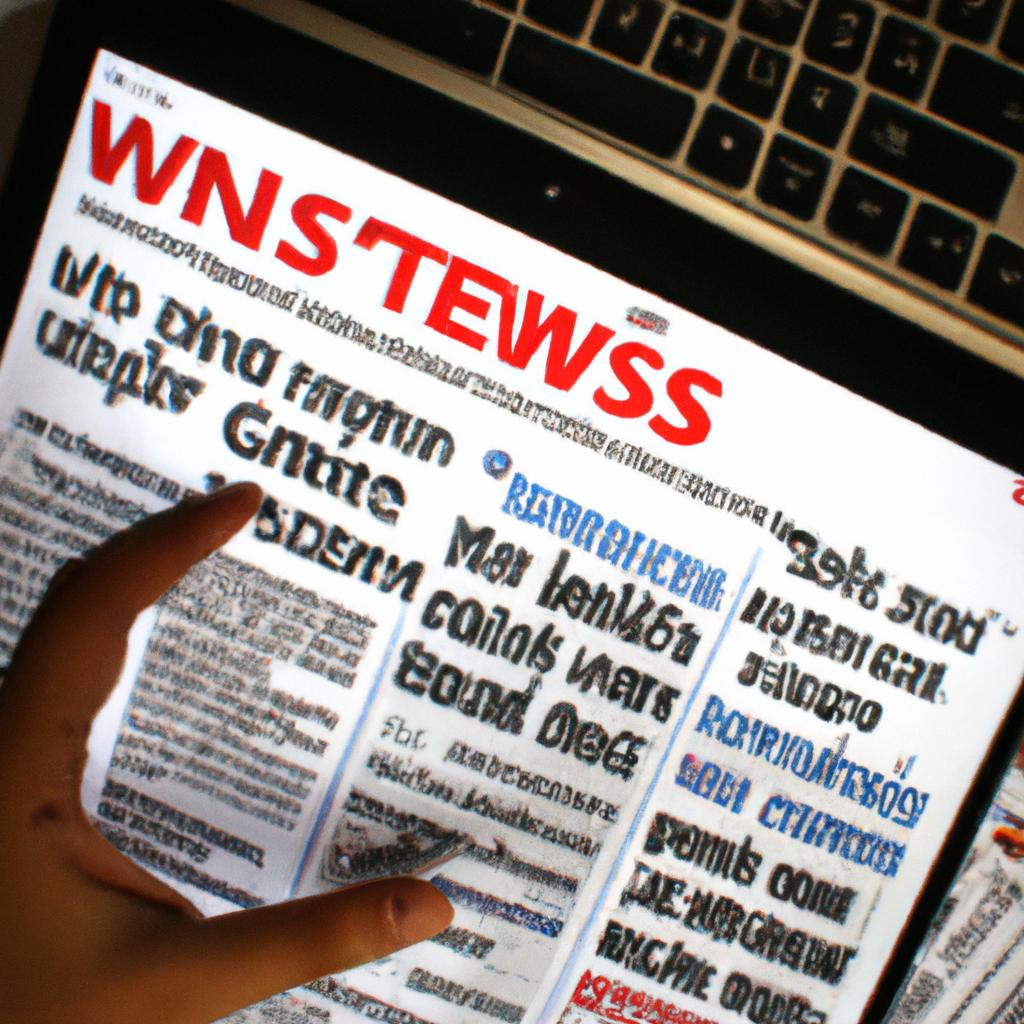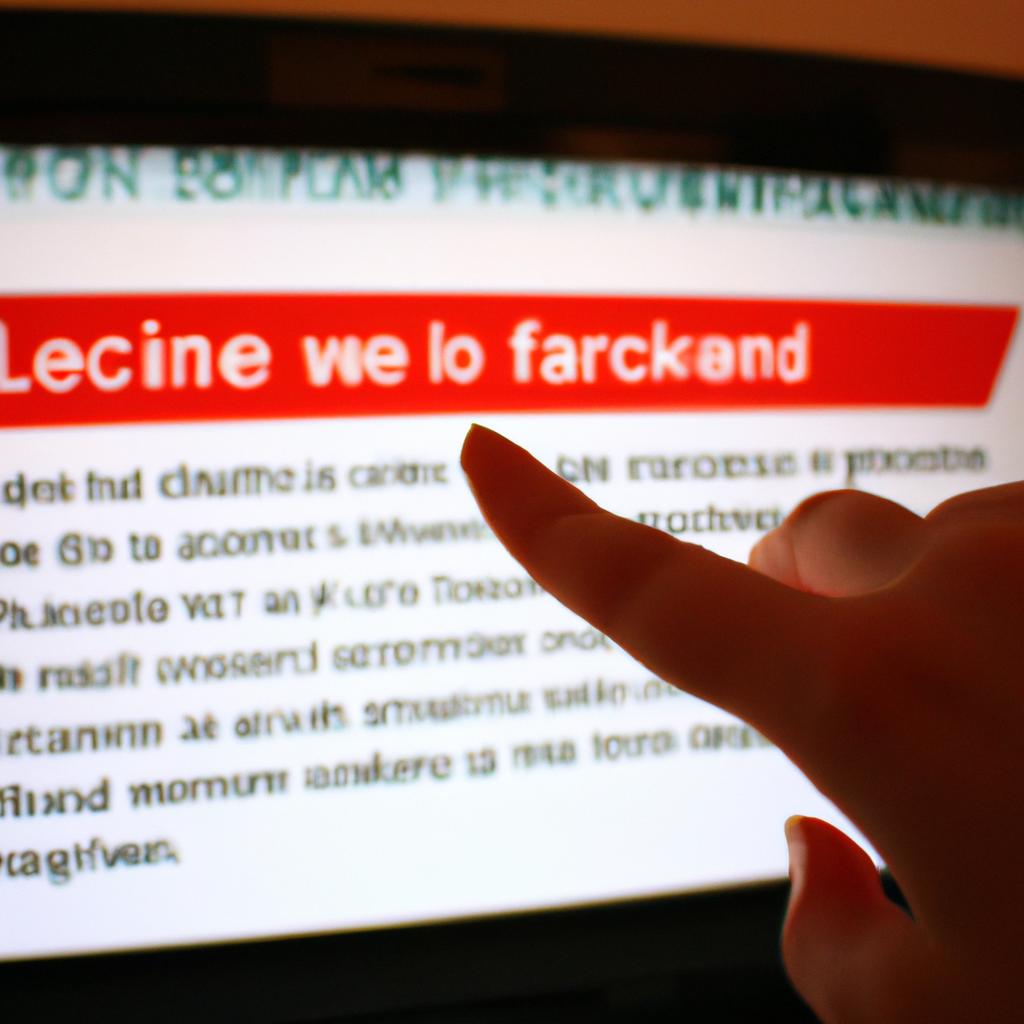The proliferation of disinformation in the news media industry has become a pressing concern in today’s information age. False or misleading information presented as legitimate news not only undermines public trust, but also poses significant challenges to democratic processes and societal cohesion. For instance, consider the case of a hypothetical news article that falsely claims a new breakthrough treatment for cancer. This misinformation could lead desperate patients to abandon evidence-based treatments and pursue ineffective or even harmful alternatives.
To address this issue, it is crucial to delve into the various mechanisms through which fake news spreads within the news media industry. Understanding how disinformation operates can help identify its sources, motivations, and potential impact on society at large. By analyzing the techniques employed by purveyors of fake news and examining their consequences, researchers and policymakers can develop effective strategies to combat this pervasive problem. This article aims to explore the prevalence of disinformation within the news media industry and shed light on the complex interplay between journalists, social media platforms, content creators, and consumers in perpetuating or countering false narratives.
The Proliferation of Misinformation
The Proliferation of Misinformation
Misinformation has become increasingly pervasive in today’s news media industry, leading to a critical need for analysis and understanding. This section explores the reasons behind the proliferation of misinformation and its impact on society.
To illustrate this issue, consider a hypothetical scenario where a well-known news outlet publishes an article containing false information about a political candidate. Despite lacking credible evidence, this piece quickly gains traction across social media platforms due to its sensationalized headline and emotionally charged content. Individuals who come across this misleading article may unknowingly share it with their network, perpetuating the spread of misinformation.
The widespread dissemination of false information can have far-reaching consequences. To emphasize the gravity of this issue, we present several key points:
- Emotional Manipulation: Misinformation often employs emotional triggers to evoke strong responses from readers, which can cloud judgment and inhibit critical thinking.
- Confirmation Bias: People tend to seek out information that aligns with their preexisting beliefs or opinions, inadvertently reinforcing misinformation they encounter.
- Social Influence: When individuals see friends or acquaintances sharing certain pieces of information online, they are more likely to perceive it as accurate and subsequently share it themselves.
- Information Overload: In an era characterized by an abundance of news sources and constant exposure to digital content, distinguishing reliable information from falsehoods becomes challenging for many consumers.
To further grasp the complexity surrounding misinformation propagation strategies employed by various actors within the news media industry, refer to Table 1 below:
| Techniques Used | Examples | Impact |
|---|---|---|
| Sensationalism | Exaggerated headlines | Provokes heightened emotions |
| Fabrication | Creating fake stories | Undermines trust in legitimate sources |
| Conspiracy theories | Spreading baseless claims | Fuels division and polarization |
| Source manipulation | Quoting unreliable sources | Misleads readers with false authority |
In light of the pervasive impact misinformation has on society, it is crucial to understand the techniques used to spread disinformation. The subsequent section will delve into these strategies and shed light on how they perpetuate falsehoods in today’s news media landscape.
[Transition Sentence]: Before exploring the various techniques employed to spread disinformation, it is important to gain a comprehensive understanding of why individuals engage in such practices within the news media industry.
Techniques Used to Spread Disinformation
The proliferation of misinformation has become a pressing issue in the news media industry, with various techniques being employed to spread disinformation. A prime example is the case study of a major social media platform used as a tool for disseminating false information during an election campaign. This platform allowed for the rapid sharing of manipulated videos and misleading headlines, resulting in widespread confusion among users.
To understand how disinformation spreads, it is crucial to recognize the techniques utilized by those seeking to deceive. These techniques can be categorized into four main strategies:
-
Fabrication: False stories are created from scratch, often using sensational language or provocative content designed to capture attention. These fabricated narratives may include fabricated quotes, events, or even entire news sources that do not exist.
-
Manipulation: Existing information is altered or selectively presented to distort its meaning or impact. This includes selectively editing images or videos, taking statements out of context, or altering headlines and captions to sway public opinion.
-
Amplification: Disinformation campaigns rely on amplifying false narratives through multiple channels simultaneously. This involves utilizing bot networks (automated accounts) to rapidly share and promote fake stories across social media platforms and online communities.
-
Impersonation: In this technique, individuals or groups pretend to be someone they are not in order to spread false information effectively. They might create fake social media profiles posing as credible sources, journalists, politicians, or experts who appear trustworthy at first glance.
Table – Examples of Techniques Used in Spreading Disinformation:
| Technique | Description |
|---|---|
| Fabrication | Creating entirely false stories with exaggerated claims and sensational elements |
| Manipulation | Distorting existing information by selective editing or presenting it out of context |
| Amplification | Rapidly spreading disinformation through bot networks and leveraging multiple communication channels |
| Impersonation | Pretending to be credible individuals or organizations to gain trust and disseminate false information effectively |
These techniques, among others, are employed by those seeking to spread disinformation for various purposes. By understanding the strategies used, it becomes possible to identify and combat these deceptive practices more effectively.
The impact of disinformation on society cannot be underestimated. In the subsequent section, we will explore how the widespread dissemination of fake news can erode public trust in media outlets and democratic processes alike.
The Impact of Disinformation on Society
Disinformation, with its pervasive nature and sophisticated techniques, has far-reaching consequences for society. By manipulating information, disinformation campaigns can shape public opinion, affect political discourse, and erode trust in traditional news media sources. To illustrate the impact of disinformation, let us consider a hypothetical case study involving a fabricated news story about a potential health crisis.
In this scenario, an online platform spreads false information claiming that a newly released medication causes severe side effects. Despite being entirely baseless, the disinformation gains traction through various means such as social media shares and search engine optimization tactics employed by malicious actors. As a result, widespread panic ensues among individuals who have been prescribed the medication or are considering it for their medical conditions.
The impact of disinformation extends beyond individual cases to societal repercussions. Here are some key points highlighting the broader consequences:
- Undermining democratic processes: Disinformation can sway public opinion during elections or important referendums by disseminating misleading narratives about candidates or policies.
- Fostering polarization: Deliberate misinformation often fuels existing divisions within society by amplifying controversial topics and exploiting emotional triggers.
- Weakening trust in institutions: When reputable news outlets become entangled in spreading fake news due to manipulation or oversight, public confidence in journalism is eroded.
- Threatening public safety: False information regarding health crises or emergencies can lead to harmful actions or prevent people from taking necessary precautions.
To grasp the magnitude of these impacts further, we present a table illustrating real-world examples where disinformation campaigns had significant societal consequences:
| Case Study | Description | Consequences |
|---|---|---|
| 2016 US Presidential | Foreign entities utilized social media platforms to spread divisive content aimed at influencing voter behavior | Increased distrust in election integrity; heightened political polarization |
| Brexit Referendum | Misleading narratives circulated during the campaign, affecting public perceptions and shaping voting decisions | Deepened divisions within society; questioned democratic legitimacy of the referendum |
| COVID-19 Disinformation | False claims linking 5G technology to the spread of coronavirus gained traction, leading to vandalism and conspiracy beliefs | Damaged critical infrastructure due to attacks on cellular towers; undermined public health efforts through misinformation propagation |
In light of these examples and their consequences, it becomes evident that addressing disinformation is crucial for maintaining a healthy information ecosystem. This section has shed light on the impacts caused by disinformation campaigns in society.
Transitioning smoothly into the subsequent section about “The Role of Social Media in Disseminating Misinformation,” we will now explore how online platforms have facilitated the rapid spread of fake news and contributed to its widespread influence.
The Role of Social Media in Disseminating Misinformation
Disinformation, also known as fake news, has become an increasingly prevalent issue in today’s society. The rapid spread of false information through various media channels has had far-reaching consequences that cannot be ignored. To illustrate the gravity of this problem, let us consider a hypothetical example: Imagine a widely-shared article claiming that a newly developed vaccine for a deadly virus is causing severe side effects and even death among those who receive it. This false information spreads like wildfire across social media platforms, leading to widespread panic and hesitation towards vaccination efforts. As a result, public health initiatives suffer setbacks, potentially jeopardizing the well-being of individuals and communities.
- Disruption of democratic processes
- Amplification of prejudices and stereotypes
- Erosion of public confidence in institutions
- Increased polarization within communities
These consequences highlight the urgency with which we must address the propagation of disinformation in our media landscape. One crucial factor contributing to its dissemination is the role played by social media platforms.
Social media platforms have emerged as powerful tools for sharing information globally at an unprecedented speed. However, their algorithms often prioritize engagement over accuracy, creating echo chambers where users are more likely to encounter content that aligns with their preexisting beliefs or biases. Consequently, misinformation can easily permeate these online spaces, gaining traction and influencing public opinion before fact-checkers have an opportunity to debunk it.
In order to combat the detrimental effects of disinformation, it is imperative that we develop strategies for identifying and fact-checking fake news effectively. In doing so, we can equip individuals with the necessary skills to critically evaluate information they encounter online and make informed decisions based on reliable sources. By promoting digital literacy education and fostering media literacy programs, we can empower individuals to navigate the complex landscape of information and mitigate the spread of disinformation.
Transitioning into the subsequent section about “Identifying and Fact-Checking Fake News,” it is crucial that we equip ourselves with effective tools and techniques in order to counteract the rampant dissemination of false information.
Identifying and Fact-Checking Fake News
The role of social media in disseminating misinformation has become increasingly prevalent in today’s news landscape. This section will delve deeper into the consequences and effects that fake news can have on society, highlighting its potential to shape public opinion and undermine trust in traditional news sources.
One example that vividly illustrates the impact of fake news is the “Pizzagate” conspiracy theory. In 2016, false rumors circulated online claiming that a popular pizza restaurant in Washington D.C. was operating a child sex trafficking ring involving high-ranking politicians. Despite being debunked by reputable sources, the story gained traction through social media platforms, leading to real-life consequences when an individual opened fire inside the restaurant based on these unfounded claims. This case demonstrates how fake news propagated through social media can result in significant harm and damage to individuals and communities.
The societal implications of fake news are far-reaching, affecting various aspects of our daily lives. Here are some key points to consider:
- Misinformation undermines democratic processes: False narratives designed to influence political opinions or sway election outcomes can erode public trust in institutions and hinder informed decision-making.
- Impacts public health: The spread of falsehoods related to health topics, such as vaccines or COVID-19 treatments, can jeopardize public safety and contribute to harmful behaviors.
- Fuels polarization and division: Disinformation often amplifies existing biases, reinforcing divisions within societies and creating echo chambers where conflicting viewpoints struggle to find common ground.
- Undermines journalistic integrity: Fake news challenges the credibility of professional journalists who adhere to ethical standards, making it harder for audiences to discern reliable information from fabricated content.
To further illustrate these impacts, let’s examine them using a table format:
| Impact | Description |
|---|---|
| Erosion of Trust | Fake news erodes trust in established news outlets and professionals, leading to skepticism and the spread of rumors. |
| Manipulation of Public Opinion | Misinformation can manipulate public opinion by shaping narratives that align with certain agendas or ideologies. |
| Damage to Reputation | Individuals and organizations may suffer reputational damage due to false information circulating about them. |
| Influence on Decision-Making Processes | Fake news has the potential to influence important decision-making processes at individual and societal levels. |
Understanding these consequences is crucial in developing strategies to combat disinformation effectively. In the following section, we will explore various approaches and initiatives aimed at countering fake news and promoting media literacy.
Transitioning into the subsequent section about “Strategies to Combat Disinformation,” it becomes imperative to address the methods used to tackle this issue head-on.
Strategies to Combat Disinformation
Transitioning from the previous section, where we delved into the process of identifying and fact-checking fake news, our focus now shifts towards exploring strategies aimed at combating disinformation within the news media industry. To illustrate the urgency and relevance of this topic, let us consider a hypothetical scenario: imagine a widely circulated article claiming that a new study has found an alarming link between a commonly used household product and cancer. This article is shared across social media platforms, causing panic among readers who fear for their health. However, upon closer examination, it becomes evident that this information is entirely false.
To effectively combat disinformation in the news media industry, various approaches have been proposed and implemented. These strategies aim to promote accuracy, transparency, and critical thinking among both journalists and consumers of news. Some key methods include:
-
Strengthening Media Literacy Education:
- Incorporating media literacy education into school curricula to equip students with skills necessary to critically evaluate information.
- Encouraging individuals to question sources, verify facts independently, and understand bias in reporting.
-
Promoting Collaborative Fact-Checking Efforts:
- Establishing partnerships between news organizations and independent fact-checkers to review content before publication or broadcast.
- Developing online platforms where users can report potential instances of misinformation for verification by experts.
-
Enhancing Journalistic Standards:
- Implementing rigorous editorial processes to ensure accurate sourcing, thorough fact-checking, and balanced reporting.
- Encouraging journalists to disclose conflicts of interest that may compromise their objectivity.
-
Engaging Technology Companies:
- Collaborating with social media platforms and search engines to develop algorithms that prioritize reliable sources over misleading ones.
- Holding technology companies accountable for addressing the spread of misinformation on their platforms through policy changes and improved moderation systems.
Table: The Impact of Disinformation
| Emotional Response | Social Consequences | Political Influence | Economic Ramifications | |
|---|---|---|---|---|
| Positive | Fear, Anger | Discord among communities | Manipulation of opinions and voter behavior | Decreased consumer trust and investing confidence |
| Negative | Confusion, Indifference | Erosion of public trust in media | Undermining democratic processes | Loss of revenue for reputable news outlets |
In conclusion, combating disinformation within the news media industry is a critical endeavor that requires a multi-faceted approach. By strengthening media literacy education, promoting collaborative fact-checking efforts, enhancing journalistic standards, and engaging technology companies, society can work towards mitigating the harmful effects of fake news. Through these collective efforts, we can foster an informed citizenry that actively questions information sources and upholds the principles of accuracy and truth in journalism.




